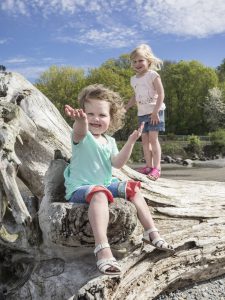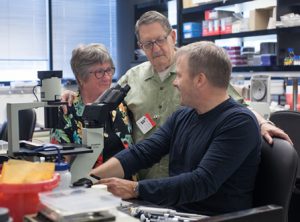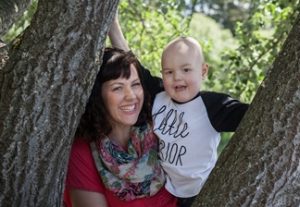
Greta Oberhofer survived a bone marrow transplant for leukemia when she was just 8 months old — but the side effects nearly killed her. Then, six months later, her family’s worst fears came to life.
“My husband put the doctor on speaker phone — he told me Greta relapsed and that her prognosis was bad,” remembers her mother, Maggie Oberhofer. “She had already suffered so much with the chemotherapy and transplant, and we didn’t want to put her through that again. We didn’t know what to do.”
The Oberhofers — who live in Portland — were considering hospice for Greta. Then they heard that Seattle Children’s Dr. Rebecca Gardner was testing a therapy that uses reprogrammed immune cells to attack certain kinds of leukemia.
“Dr. Gardner said not to give up because her therapy was putting kids like Greta in remission, and that the side effects were often a lot easier to tolerate,” Oberhofer says. “We suddenly had a way forward.”
A few months later, the Oberhofers watched Greta’s reprogrammed cells drip into her body. Two weeks after that, her cancer was in remission.
Greta, now 3, was one of the first patients in a study that’s part of Seattle Children’s push to make immunotherapy the biggest cancer treatment breakthrough of our time. Of the 42 children with acute lymphoblastic leukemia (ALL) who have participated in the study to date, approximately 93% achieved initial remission.
“It’s astounding — standard therapies weren’t working for these kids and they faced a 10% to 20% chance of survival,” Gardner says. “It shows how immunotherapy research is moving us toward a world where pediatric cancer is just a bump in the road instead of a life-altering ordeal.”
To learn more about Greta’s story, watch the video below.
https://youtube.com/watch?v=oAoc9VD4krs
A game-changing therapy
When Dr. Michael Jensen started treating children with cancer in the 1990s, he came face-to-face with kids who were cured of the disease but saddled with side effects like learning disabilities, hearing and eyesight problems, and increased risk of diabetes, heart disease and future cancers.
“Even the best therapies can take a brutal toll,” Jensen says. “I knew there had to be a better way.”

He joined other researchers on a mission to reprogram T cells — white blood cells that fight infections — to find and kill cancer cells. He showed that these modified cells could wipe out cancer in the lab. In 2011, Jensen came to Seattle Children’s to turn immunotherapy into a real-world cure.
Now Seattle Children’s is among a small handful of institutions at the forefront of developing, testing and refining immunotherapies for children. The study that Greta participated in is among the world’s first clinical studies of T-cell therapy for ALL — and the only one open to children under age 3.
The therapy starts by removing T cells from a patient’s blood sample. Then Gardner’s team inserts DNA that tells the T cells to recognize CD19 — a protein found on some ALL cells. The re-engineered cells are infused back into the patient, where they seek out and destroy cancer cells.
Gardner’s study and similar research at other institutions confirm that immunotherapy is a safe and viable way to treat cancer. But many hurdles remain before the therapy can substitute for today’s treatments.
“It’s easy to forget we’re still in the early phases of understanding how T-cell therapy works and making it more effective,” Gardner says. “We hope to be able to offer it to newly diagnosed patients in about 10 years.”
Goal: prevent relapse
After Jude Anderson’s leukemia relapsed a second time, his family came from Arizona to participate in Gardner’s ALL study. The re-engineered T cells put Jude, then 2, into remission for five months, but he suffered a third relapse in April.
Jude isn’t alone. Seventeen participants in Gardner’s study have suffered a relapse.
Of those who relapse, about half are like Jude: their reprogrammed T cells don’t stay alive long enough to permanently keep leukemia at bay. Gardner’s colleague Colleen Annesley will be launching a trial that uses a vaccine to entice the T cells to stick around.
In the other half of patients who relapse, the leukemia outsmarts the therapy by coming back in a form that no longer expresses CD19. This lets the leukemia cells fly under the T cells’ radar.
Next year, Gardner plans to start a trial of T cells that are trained to recognize both CD19 and another protein called CD22. This might help the T cells stand guard and attack the leukemia if it returns, particularly if the leukemia no longer expresses CD19.
“It breaks my heart when I hear that a patient relapses,” Gardner says, “and it makes me even more motivated to pinpoint why the leukemia comes back and find ways to head it off.”
Targeting other diseases
As Gardner’s research moves forward, her colleagues are pursuing immunotherapies for many other childhood cancers.
Dr. Julie Park is leading one of the world’s first clinical studies of T-cell therapy for neuroblastoma, which is the deadliest childhood cancer. And Dr. Courtney Crane is devising ways to help re-engineered T cells break through brain tumors’ defenses.
Their research is part of Seattle Children’s larger effort to use immunotherapy to improve treatment for many childhood diseases. For instance, Drs. David Rawlings and Andrew Scharenberg are reprogramming T cells in ways that could disarm type 1 diabetes.
“We’re only scratching the surface of our potential to use the immune system to cure children and help them lead happier healthier lives,” Rawlings says.
Fundraising goes national
In 2014, Seattle Children’s launched Strong Against Cancer — a national initiative to raise $100 million to accelerate our immunotherapy researchers’ progress.
“Our goal is to develop therapies that cure children worldwide,” says Doug Picha, president of Seattle Children’s Hospital and Research Foundation. “To do that, we needed to expand our fundraising horizons and connect with people who have been touched by cancer, no matter where they’re from.”
Strong Against Cancer has raised more than $30 million so far, from individuals in all 50 states, from corporate sponsors and from local individuals like Robert Evans and Patricia Siewert.
Evans and Siewert see a parallel between childhood cancer and a health scourge from an earlier time: polio. As children, Evans and Siewert had nightmares about getting polio and being confined to an iron lung. When Jonas Salk developed a vaccine that eradicated the disease, they both realized how research can transform the medical landscape.
“We want to see Dr. Jensen and his team do for cancer what Salk did for polio,” Evans says.
Seattle Children’s immunotherapy research wouldn’t be possible without donor support because the National Institutes of Health offers very little funding for clinical trials or many other aspects of our work, such as manufacturing the T-cell therapies.
“The fact that children are in remission today is a direct result of our donors’ generosity — and Strong Against Cancer is helping us carry the momentum forward,” Jensen says.
New hope for Jude

T-cell therapy hasn’t been the magic bullet that Jude’s family hoped for but they’re grateful it bought him a few more months of being cancer-free. When he was in remission, they went to Disneyland twice and enjoyed Christmas at home.
After chemotherapy slowed Jude’s latest relapse, he came back to Seattle for another dose of modified T cells.
“This field is moving so fast that, if we can buy patients even a few more months, there’s a chance that there will be a new therapy available to help them,” Gardner says.
Jude’s mother, Barbara Anderson, hopes one of the therapies will put Jude back in remission and help him get strong enough to endure a second bone marrow transplant, which could prevent relapses once and for all.
“I always think about the first families who let their children get chemotherapy for leukemia,” Anderson says. “I’m so grateful for their bravery – it helped save so many kids. Hopefully, in 10 years, families will look back at Jude the same way.”
If you are interested in supporting the advancement of immunotherapy and cancer research at Seattle Children’s, please visit our donation page.
Resources
- Doughnut Shop Tip in Texas Leads Family to Immunotherapy Cancer Trial, Zane Becomes Cancer-Free
- Ben Towne Center for Childhood Cancer Research
- T-Cell Immunotherapy for Leukemia (Known as PLAT-02)
- Families Find Hope in Success of Cancer Immunotherapy
- Researchers Work Toward New Type 1 Diabetes Therapies For Patients Like Juliana

